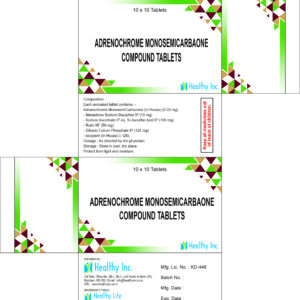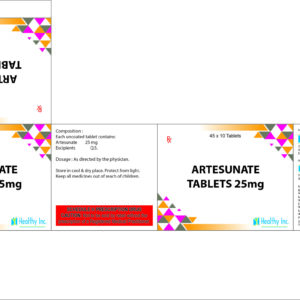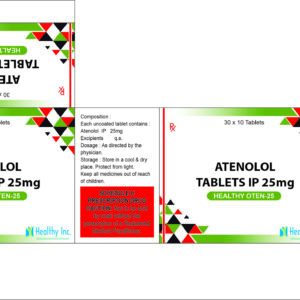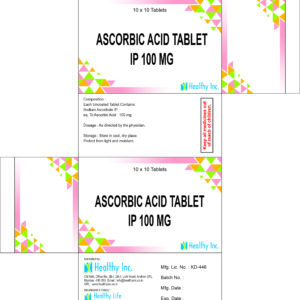Description
Pentoxifylline Tablet:
Healthy Incorporation and Healthy life pharma Pvt ltd are one of the leading manufacturer, supplier, and exporter of Pentoxifylline tablet 400 mg, in India and serving the world with best quality pharmaceutical products.
Pentoxifylline tablet Manufacturer:
Healthy incorporation and Healthy life pharma Pvt ltd, is Mumbai Based WHO GMP certified manufacturer of injection, tablets, capsules, liquid, dry syrups, pre-filled syringes, ointments etc. with an extensive experience of over 45 years in manufacturing and have reach in many countries. We are committed to provide a stock of highly effective Pentoxifylline tablets to our innumerable clients with the help of our well-experienced pharmaceutical specialists.
Uses of Pentoxifylline tablet:
Pentoxifylline tablet belongs to a group of medication known as hemorheological agents. it is a used to improve the symptoms of a certain blood flow problem in the legs/arms (intermittent claudicating due to occlusive artery disease). It reduces the muscle aching, pain, cramps while doing exercise, including walking, that occurs with intermittent claudicating. Pentoxifylline tablet is not a cure for intermittent claudicating. Pentoxifylline tablets help blood flow more smoothly through narrowed arteries. This improves the amount of oxygen which is delivered by the blood when the muscles need more specially during exercise and thereby helps in increasing walking distance and duration.
This tablet is available only on doctor prescription.
Additional Information of Pentoxifylline tablet:
Product Name Pentoxifylline tablet
Composition & Active ingredients Pentoxifylline
Potency 400 mg
Therapeutic use Blood flow problem
Packing
10 Tablets (1 Box)
Dosage As per Doctor Prescription
Precautions of Pentoxifylline tablet:
Please inform doctor your medical history of any allergy, liver disease, kidney disease, heart disease, coronary heart disease, heart attack, stroke, stomach problems. Consult your doctor if you are pregnant or planning to get pregnant, or breast- feeding mother.
Side Effects of Pentoxifylline tablet:
Most of the time there is no serious side effects. Some common side effects may arise after starting medication, as your body adjusts to medicine. If any of your symptoms worsen then consult your doctor immediately
Headache
Nausea
Vomiting
Gas
Bloating
Stomach upset
Blurred vision
Chest pain
Diarrhea
Loss of appetite
Low RBC
Inflammation of brain
Seizure
Low platelet count
Swelling
Flushing
For Detailed Product Information Contact Us at +91 7710003340, If you need Any assistance in selecting our Products that fits your requirements. If you’re looking for any product that you’re not seeing here, please contact our support team.
Pentoxifylline tablet
Pentoxifylline is a medication that is available in tablet form. It is used to improve blood flow in people with certain circulatory disorders. This medication works by decreasing the viscosity (thickness) of blood and increasing the flexibility of red blood cells, which can help blood flow more easily through the narrowed blood vessels. Some of the conditions for which pentoxifylline may be prescribed include:
Peripheral artery disease (PAD): Pentoxifylline can help improve symptoms such as leg pain, cramps, and intermittent claudication in individuals with PAD.
Chronic venous insufficiency: It may be used to alleviate symptoms associated with this condition, such as leg swelling, pain, and skin changes.
Peyronie’s disease: Pentoxifylline has been used in some cases to treat the penile curvature and pain associated with Peyronie’s disease.
Pentoxifylline is typically taken orally as tablets, and the dosage and duration of treatment will be determined by your healthcare provider based on your specific condition and medical history. It is important to follow your healthcare provider’s instructions and take the medication as prescribed.
As with any medication, pentoxifylline can have side effects and interactions with other drugs, so it’s crucial to inform your healthcare provider about any other medications or medical conditions you may have before starting treatment. Common side effects of pentoxifylline may include nausea, vomiting, and stomach discomfort.
Please note that this information is based on my knowledge as of September 2021, and there may have been developments or changes in medical guidelines or available formulations since that time. Always consult with a healthcare professional for the most up-to-date information and guidance on the use of pentoxifylline or any other medication.
Pentoxifylline is a medication that is available in tablet form. It is used to improve blood flow and reduce the viscosity (thickness) of blood. This can be beneficial in certain medical conditions, such as peripheral arterial disease (PAD) and intermittent claudication. It is also sometimes used in the management of conditions like chronic venous insufficiency and diabetic neuropathy.
Pentoxifylline works by decreasing the viscosity of blood, which helps it flow more easily through narrow blood vessels. It can also improve oxygen delivery to tissues and reduce inflammation.
The specific dosage and instructions for taking pentoxifylline tablets will vary depending on your medical condition and the prescribing healthcare provider’s recommendations. It’s important to follow your doctor’s instructions regarding the use of this medication and any potential side effects or interactions with other medications you may be taking.
Common brand names for pentoxifylline include Trental and Pentoxil. If you have any questions or concerns about this medication, it’s best to consult your healthcare provider or pharmacist for more information.
Pentoxifylline is a medication that is available in tablet form and is used to improve blood flow. It is a type of medication known as a hemorheologic agent, which means it affects the flow properties of blood. Pentoxifylline works by decreasing the viscosity (thickness) of blood, which can help improve blood circulation.
Here are some key points about pentoxifylline tablets:
Medical Uses: Pentoxifylline is commonly prescribed to improve blood flow in patients with peripheral vascular disease, a condition that causes reduced blood flow to the limbs. It can help relieve symptoms such as intermittent claudication, which is pain or cramping in the legs during physical activity.
Mechanism of Action: The exact way pentoxifylline works is not fully understood, but it is believed to increase red blood cell flexibility and reduce platelet aggregation. These actions can help blood flow more freely through narrowed or blocked blood vessels.
Dosage: The dosage of pentoxifylline varies depending on the condition being treated. It is typically taken in tablet form and can be taken with or without food. Your healthcare provider will determine the appropriate dose for your specific situation.
Side Effects: Common side effects of pentoxifylline may include nausea, vomiting, dizziness, headache, and gastrointestinal discomfort. If you experience severe or persistent side effects, it’s important to contact your healthcare provider.
Precautions: Pentoxifylline should be used with caution in individuals with a history of bleeding disorders, peptic ulcers, or recent surgery. It may interact with certain medications, so it’s important to inform your doctor of all the medications you are taking.
Duration of Treatment: The duration of pentoxifylline treatment will depend on the underlying medical condition and your response to the medication. Your doctor will determine the appropriate duration of treatment.
Generic and Brand Names: Pentoxifylline is available as a generic medication, but it is also sold under various brand names, including Trental and Pentoxil.
Consultation: You should only take pentoxifylline under the supervision and prescription of a healthcare professional. They will assess your specific medical condition and determine whether this medication is appropriate for you.
As with any medication, it’s important to follow your healthcare provider’s instructions and ask any questions you may have about pentoxifylline to ensure safe and effective use. If you have any concerns or experience adverse effects, consult your doctor promptly.
Pentoxifylline is a medication that comes in tablet form and is used to improve blood flow. It is typically prescribed for various vascular disorders, including peripheral arterial disease (PAD). Here are some key points about pentoxifylline tablets:
Mechanism of Action: Pentoxifylline works by decreasing the viscosity of blood, making it less sticky and more fluid. This helps improve blood flow, especially in the smaller blood vessels.
Indications: Pentoxifylline is commonly used to treat intermittent claudication, a condition in which reduced blood flow to the limbs causes pain or cramping during physical activity. It may also be used in other conditions where improved blood flow is necessary.
Dosage: The dosage of pentoxifylline can vary depending on the specific condition being treated and the patient’s response to the medication. It is typically taken orally in tablet form, and the usual dosage is 400 mg three times a day with meals.
Side Effects: Common side effects may include gastrointestinal symptoms like nausea, vomiting, and abdominal discomfort. Less commonly, it can cause dizziness, headache, and skin rash. Serious side effects are rare but can include severe allergic reactions.
Precautions: Pentoxifylline may not be suitable for individuals with certain medical conditions, such as active bleeding, recent stroke, or severe heart conditions. It is important to inform your healthcare provider about any other medications or supplements you are taking to avoid potential drug interactions.
Duration of Treatment: Treatment with pentoxifylline is often long-term, as it aims to improve blood flow and alleviate symptoms over time. Your healthcare provider will determine the appropriate duration of treatment.
Generic and Brand Names: Pentoxifylline is available as a generic medication, but it is also sold under various brand names, including Trental and Pentoxil.
Consultation: It’s important to consult with a healthcare professional before starting pentoxifylline or any medication. They will assess your specific medical condition and determine if this medication is appropriate for you.
Compliance: If prescribed, it is essential to take pentoxifylline tablets as directed by your healthcare provider. Skipping doses or stopping the medication prematurely may limit its effectiveness.
Remember that this information is provided as a general overview. For personalized guidance and to understand the specific details of your treatment, it is crucial to consult with a healthcare professional or pharmacist. They can provide you with the most accurate and up-to-date information regarding pentoxifylline and its use in your particular situation.
Pentoxifylline is a medication that is available in tablet form. It is primarily used to improve blood flow in people with circulatory disorders. Pentoxifylline works by reducing the viscosity (thickness) of blood, making it flow more easily through narrow blood vessels. This can help improve blood circulation to various parts of the body, particularly in cases where there is reduced blood flow due to conditions like peripheral artery disease.
Key points about pentoxifylline tablets include:
Indications: Pentoxifylline is commonly used to treat intermittent claudication, a condition in which reduced blood flow to the legs causes pain and cramping during physical activity. It may also be used in other circulatory disorders.
How It Works: Pentoxifylline improves blood flow by decreasing the viscosity of blood and increasing red blood cell flexibility. This helps blood circulate more efficiently, especially in narrow or blocked blood vessels.
Dosage: The dosage of pentoxifylline can vary depending on the condition being treated. It is typically taken orally, usually two or three times a day with meals to reduce the risk of stomach upset.
Side Effects: Common side effects can include nausea, vomiting, headache, dizziness, and flushing. Serious side effects are rare but can include bleeding, signs of an allergic reaction, and severe skin reactions. If you experience any serious side effects, seek medical attention immediately.
Precautions: Pentoxifylline should be used with caution in individuals with certain medical conditions, such as bleeding disorders, recent surgery, or a history of heart problems. It may interact with other medications, so it’s important to inform your healthcare provider about all the medications you are taking.
Duration of Treatment: The duration of treatment with pentoxifylline will depend on the specific medical condition being treated. Your healthcare provider will determine the appropriate length of treatment.
Generic and Brand Names: Pentoxifylline is available as a generic medication and under various brand names, including Trental and Pentoxil.
It’s important to use pentoxifylline only as prescribed by a healthcare professional and to follow their instructions closely. If you have any questions or concerns about this medication, be sure to discuss them with your healthcare provider.
Pentoxifylline is a medication commonly available in tablet form. It is used to improve blood flow and is often prescribed to treat various vascular and circulatory problems. Some of its uses include:
Peripheral Artery Disease (PAD): Pentoxifylline can help improve blood circulation in the legs and arms, relieving symptoms such as pain and cramping associated with PAD.
Intermittent Claudication: This is a symptom of PAD, and pentoxifylline can help reduce leg pain and improve walking distances for individuals with this condition.
Chronic Venous Insufficiency (CVI): Pentoxifylline may be used to alleviate symptoms of CVI, such as leg swelling and pain.
Alcoholic Hepatitis: Pentoxifylline may be used as an adjunctive treatment in cases of severe alcoholic hepatitis.
Sickle Cell Disease: It has also been used to reduce the frequency and severity of painful crises in people with sickle cell disease.
Pentoxifylline works by reducing the viscosity (thickness) of blood, which in turn enhances blood flow to the affected areas. It also has anti-inflammatory properties.
As with any medication, it is important to take pentoxifylline as prescribed by your healthcare provider and to follow their instructions regarding dosage and duration of treatment. Be sure to discuss any potential side effects and contraindications with your doctor before starting this medication.
Note: Healthy Incorporation and Healthy life pharma Pvt ltd tries to ensure that all information, whether in relation to the products, services, offerings provided as part of this website is correct at the time of inclusion on the website, Unauthorized use of any materials contained on this website may violate copyright laws, trademark laws, the laws of privacy and publicity, certain communications statutes and regulations and other applicable laws and regulations. All copyright and other intellectual property rights in this material are owned by Healthy Incorporation and Healthy life pharma Pvt ltd. Please connect with us to discuss precise product specifications and requirements and obtain advice on which products are suitable for your requirement or you can write to us
Pentoxifylline Tablets (Regular SRC under development) , पेंटोक्सिफाइलाइन टैबलेट (विकासाधीन नियमितएसआरसी), tabletas de pentoxifilina de (regularSRC en desarrollo), comprimés de pentoxifylline (régulier SRC en cours de développement), قرص بنتوكسيفيلين ملغ (العادي SRC قيد التطوير), 片己酮可可鹼片 毫克(常規SRC 正在開發中), Comprimidos de Pentoxifilina (RegularSRC em desenvolvimento) , Таблетки пентоксифиллина (обычный SRC в разработке) ,ペントキシフィリン錠(通常のSRC開発中) ,suppliers India, Exporters,Wholesalers India, Distributors India, Generic Supplier,who gmp certified manufacturer






